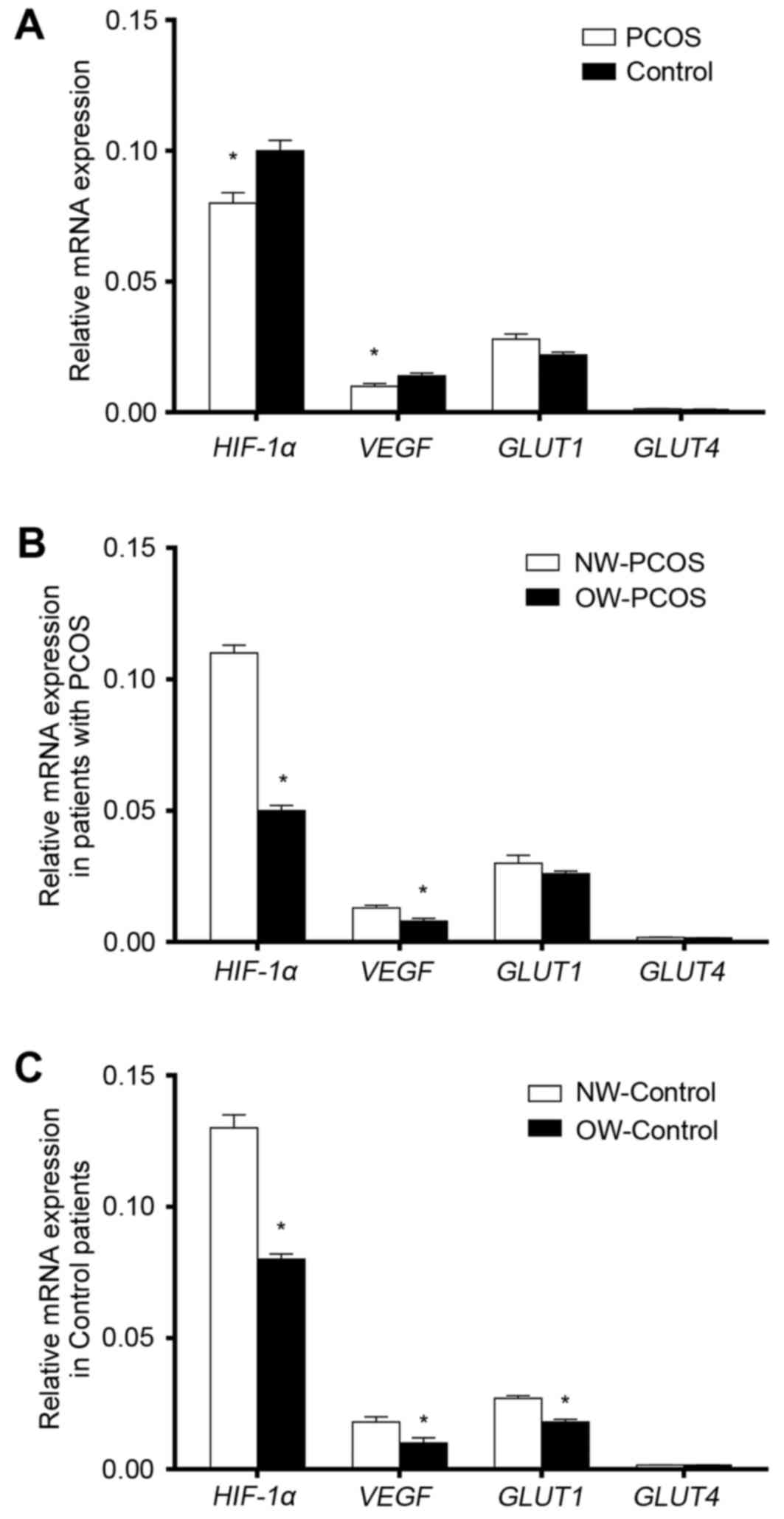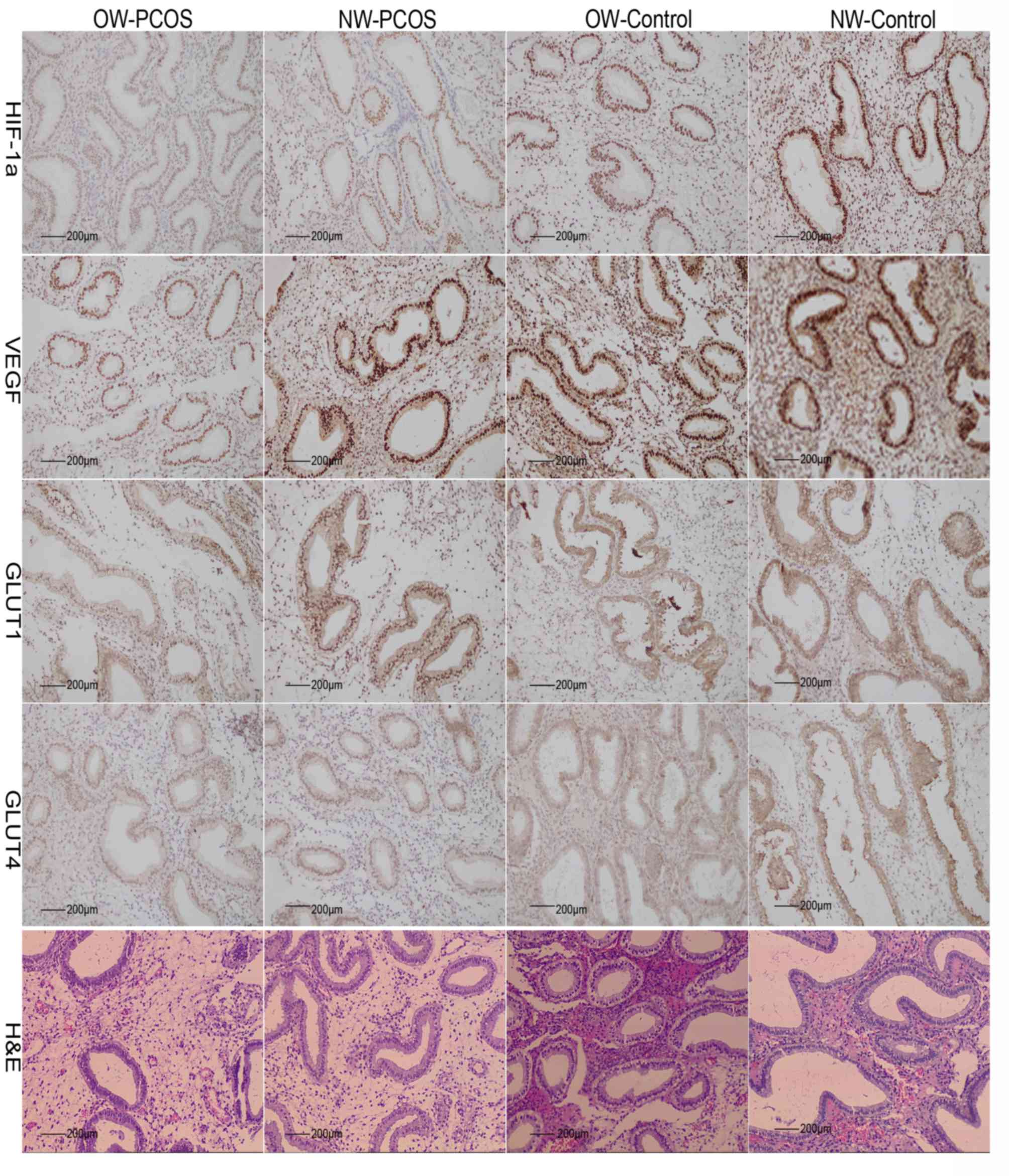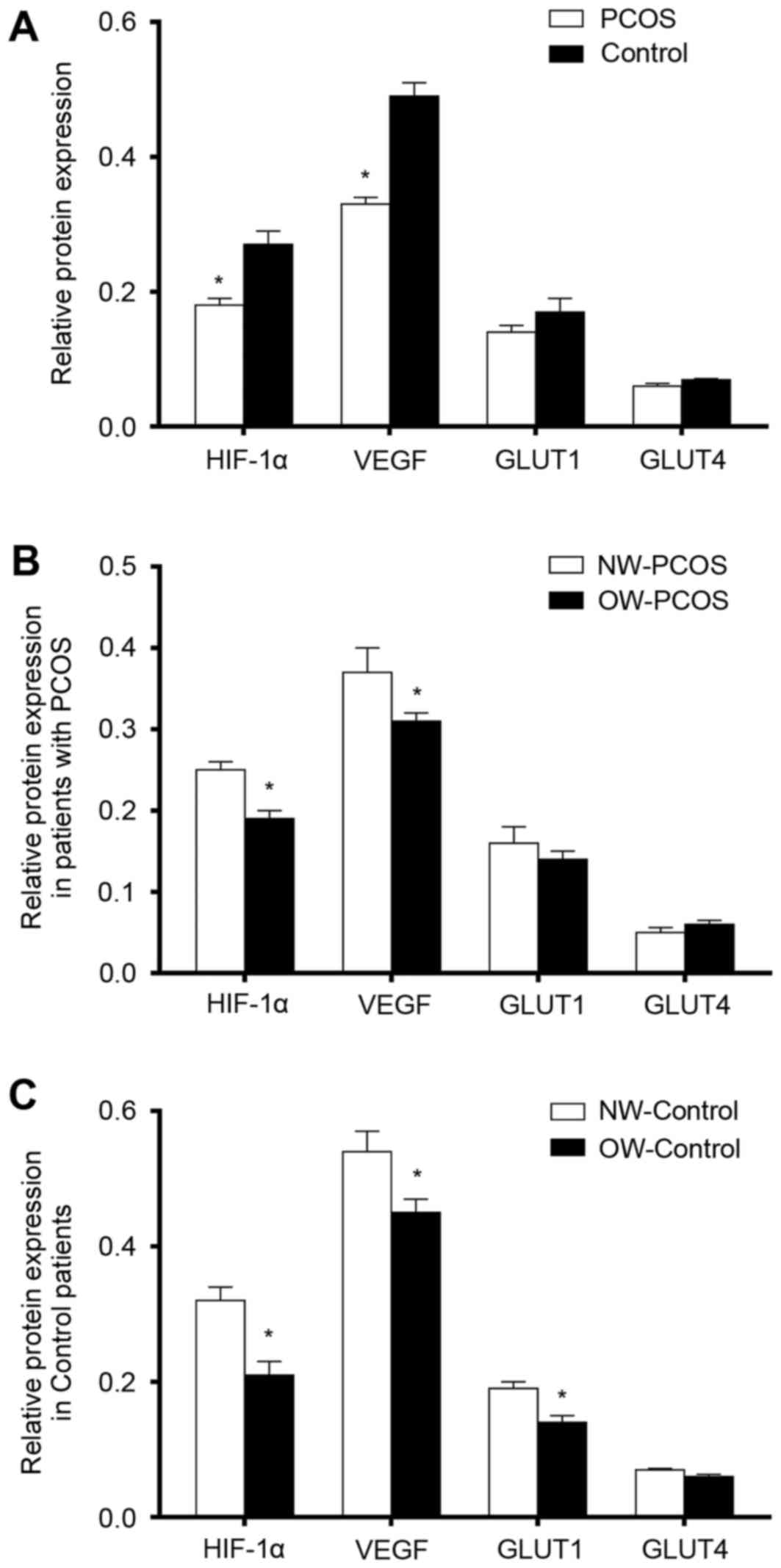|
1
|
Duncan WC: A guide to understanding
polycystic ovary syndrome (PCOS). J Fam Plann Reprod Health Care.
40:217–225. 2014. View Article : Google Scholar : PubMed/NCBI
|
|
2
|
Lim SS, Davies MJ, Norman RJ and Moran LJ:
Overweight, obesity and central obesity in women with polycystic
ovary syndrome: A systematic review and meta-analysis. Hum Reprod
Update. 18:618–637. 2012. View Article : Google Scholar : PubMed/NCBI
|
|
3
|
Bellver J, Mifsud A, Grau N, Privitera L
and Meseguer M: Similar morphokinetic patterns in embryos derived
from obese and normoweight infertile women: A time-lapse study. Hum
Reprod. 28:794–800. 2013. View Article : Google Scholar : PubMed/NCBI
|
|
4
|
Provost MP, Acharya KS, Acharya CR, Yeh
JS, Steward RG, Eaton JL, Goldfarb JM and Muasher SJ: Pregnancy
outcomes decline with increasing body mass index: Analysis of
239,127 fresh autologous in vitro fertilization cycles from the
2008–2010 Society for Assisted Reproductive Technology registry.
Fertil Steril. 105:663–669. 2016. View Article : Google Scholar : PubMed/NCBI
|
|
5
|
Lopes IM, Baracat MC, Mde Simoes J, Simões
RS, Baracat EC and Soares JM Jr: Endometrium in women with
polycystic ovary syndrome during the window of implantation. Rev
Assoc Med Bras (1992). 57:702–709. 2011.(In English, Portuguese).
PubMed/NCBI
|
|
6
|
Savaris RF, Groll JM, Young SL, DeMayo FJ,
Jeong JW, Hamilton AE, Giudice LC and Lessey BA: Progesterone
resistance in PCOS endometrium: A microarray analysis in clomiphene
citrate-treated and artificial menstrual cycles. J Clin Endocrinol
Metab. 96:1737–1746. 2011. View Article : Google Scholar : PubMed/NCBI
|
|
7
|
Lam P, Johnson I and Raine-Fenning N:
Endometrial blood flow is impaired in women with polycystic ovarian
syndrome who are clinically hyperandrogenic. Ultrasound Obstet
Gynecol. 34:326–334. 2009. View
Article : Google Scholar : PubMed/NCBI
|
|
8
|
Torry DS, Leavenworth J, Chang M,
Maheshwari V, Groesch K, Ball ER and Torry RJ: Angiogenesis in
implantation. J Assist Reprod Genet. 24:303–315. 2007. View Article : Google Scholar : PubMed/NCBI
|
|
9
|
Kingdom JC and Kaufmann P: Oxygen and
placental vascular development. Adv Exp Med Biol. 474:259–275.
1999. View Article : Google Scholar : PubMed/NCBI
|
|
10
|
Schofield CJ and Ratcliffe PJ: Oxygen
sensing by HIF hydroxylases. Nat Rev Mol Cell Biol. 5:343–354.
2004. View
Article : Google Scholar : PubMed/NCBI
|
|
11
|
Kaelin WG Jr and Ratcliffe PJ: Oxygen
sensing by metazoans: The central role of the HIF hydroxylase
pathway. Mol Cell. 30:393–402. 2008. View Article : Google Scholar : PubMed/NCBI
|
|
12
|
Majmundar AJ, Wong WJ and Simon MC:
Hypoxia-inducible factors and the response to hypoxic stress. Mol
Cell. 40:294–309. 2010. View Article : Google Scholar : PubMed/NCBI
|
|
13
|
Han ZB, Ren H, Zhao H, Chi Y, Chen K, Zhou
B, Liu YJ, Zhang L, Xu B, Liu B, et al: Hypoxia-inducible factor
(HIF)-1 alpha directly enhances the transcriptional activity of
stem cell factor (SCF) in response to hypoxia and epidermal growth
factor (EGF). Carcinogenesis. 29:1853–1861. 2008. View Article : Google Scholar : PubMed/NCBI
|
|
14
|
Gómez-Raposo C, Mendiola M, Barriuso J,
Casado E, Hardisson D and Redondo A: Angiogenesis and ovarian
cancer. Clin Transl Oncol. 11:564–571. 2009. View Article : Google Scholar : PubMed/NCBI
|
|
15
|
Critchley HO, Osei J, Henderson TA,
Boswell L, Sales KJ, Jabbour HN and Hirani N: Hypoxia-inducible
factor-1alpha expression in human endometrium and its regulation by
prostaglandin E-series prostanoid receptor 2 (EP2). Endocrinology.
147:744–753. 2006. View Article : Google Scholar : PubMed/NCBI
|
|
16
|
Shibuya M: Vascular endothelial growth
factor and its receptor system: Physiological functions in
angiogenesis and pathological roles in various diseases. J Biochem.
153:13–19. 2013. View Article : Google Scholar : PubMed/NCBI
|
|
17
|
Binder NK, Evans J, Gardner DK, Salamonsen
LA and Hannan NJ: Endometrial signals improve embryo outcome:
Functional role of vascular endothelial growth factor isoforms on
embryo development and implantation in mice. Hum Reprod.
29:2278–2286. 2014. View Article : Google Scholar : PubMed/NCBI
|
|
18
|
Hayashi M, Sakata M, Takeda T, Yamamoto T,
Okamoto Y, Sawada K, Kimura A, Minekawa R, Tahara M, Tasaka K and
Murata Y: Induction of glucose transporter 1 expression through
hypoxia-inducible factor 1alpha under hypoxic conditions in
trophoblast-derived cells. J Endocrinol. 183:145–154. 2004.
View Article : Google Scholar : PubMed/NCBI
|
|
19
|
Zhai J, Liu CX, Tian ZR, Jiang QH and Sun
YP: Effects of metformin on the expression of GLUT4 in endometrium
of obese women with polycystic ovary syndrome. Biol Reprod.
87:292012. View Article : Google Scholar : PubMed/NCBI
|
|
20
|
Goteri G, Lucarini G, Montik N, Zizzi A,
Stramazzotti D, Fabris G, Tranquilli AL and Ciavattini A:
Expression of vascular endothelial growth factor (VEGF), hypoxia
inducible factor-1alpha (HIF-1alpha), and microvessel density in
endometrial tissue in women with adenomyosis. Int J Gynecol Pathol.
28:157–163. 2009. View Article : Google Scholar : PubMed/NCBI
|
|
21
|
Giudice LC: Application of functional
genomics to primate endometrium: Insights into biological
processes. Reprod Biol Endocrinol. 4 Suppl 1:S42006. View Article : Google Scholar : PubMed/NCBI
|
|
22
|
Rotterdam ESHRE/ASRM-Sponsored PCOS
consensus workshop group: Revised 2003 consensus on diagnostic
criteria and long-term health risks related to polycystic ovary
syndrome (PCOS). Hum Reprod. 19:41–47. 2004. View Article : Google Scholar : PubMed/NCBI
|
|
23
|
Cole TJ, Bellizzi MC, Flegal KM and Dietz
WH: Establishing a standard definition for child overweight and
obesity worldwide: International survey. BMJ. 320:1240–1243. 2000.
View Article : Google Scholar : PubMed/NCBI
|
|
24
|
Xing XY, Yang WY and Yang ZJ: The
diagnostic significance of homeostasis model assessment of insulin
resistance in metabolic syndrome among subjects with different
glucose tolerance. Chin J Diabetes. 12:182–186. 2004.(In
Chinese).
|
|
25
|
Bellver J, Pellicer A, Garcia-Velasco JA,
Ballesteros A, Remohí J and Meseguer M: Obesity reduces uterine
receptivity: Clinical experience from 9,587 first cycles of ovum
donation with normal weight donors. Fertil Steril. 100:1050–1058.
2013. View Article : Google Scholar : PubMed/NCBI
|
|
26
|
Liu Z, Hao C, Song D, Zhang N, Bao H and
Qu Q: Androgen receptor coregulator CTBP1-AS is associated with
polycystic ovary syndrome in chinese women: A preliminary study.
Reprod Sci. 22:829–837. 2015. View Article : Google Scholar : PubMed/NCBI
|
|
27
|
Fang Y, Yu S, Ma Y, Sun P, Ma D, Ji C and
Kong B: Association of Dll4/notch and HIF-1α-VEGF signaling in the
angiogenesis of missed abortion. PLoS One. 8:e706672013. View Article : Google Scholar : PubMed/NCBI
|
|
28
|
Pfaffl MW: A new mathematical model for
relative quantification in real-time RT-PCR. Nucleic Acids Res.
29:e452001. View Article : Google Scholar : PubMed/NCBI
|
|
29
|
Schmittgen TD and Livak KJ: Analyzing
real-time PCR data by the comparative C(T) method. Nat Protoc.
3:1101–1108. 2008. View Article : Google Scholar : PubMed/NCBI
|
|
30
|
Fischer AH, Jacobson KA, Rose J and Zeller
R: Hematoxylin and eosin staining of tissue and cell sections. CSH
Protoc. 2008:pdb prot4986. 2008.
|
|
31
|
Dubicke A, Fransson E, Centini G,
Andersson E, Byström B, Malmström A, Petraglia F,
Sverremark-Ekström E and Ekman-Ordeberg G: Pro-inflammatory and
anti-inflammatory cytokines in human preterm and term cervical
ripening. J Reprod Immunol. 84:176–185. 2010. View Article : Google Scholar : PubMed/NCBI
|
|
32
|
Rivero R, Garin CA, Ormazabal P, Silva A,
Carvajal R, Gabler F, Romero C and Vega M: Protein expression of
PKCZ (Protein Kinase C Zeta), Munc18c and Syntaxin-4 in the insulin
pathway in endometria of patients with polycystic ovary syndrome
(PCOS). Reprod Biol Endocrinol. 10:172012. View Article : Google Scholar : PubMed/NCBI
|
|
33
|
García V, Oróstica L, Poblete C, Rosas C,
Astorga I, Romero C and Vega M: Endometria from obese PCOS women
with hyperinsulinemia exhibit altered adiponectin signaling. Horm
Metab Res. 47:901–909. 2015. View Article : Google Scholar : PubMed/NCBI
|
|
34
|
Noyes RW, Hertig AT and Rock J: Dating the
endometrial biopsy. Am J Obstet Gynecol. 122:262–263. 1975.
View Article : Google Scholar : PubMed/NCBI
|
|
35
|
Bianju Xu and Hongmei Li: The progress of
HIF-1a in the embryo development. Chinese J Trauma and Disab Med.
20:208–210. 2011.(In Chinese).
|
|
36
|
Tsuzuki T, Okada H, Cho H, Tsuji S,
Nishigaki A, Yasuda K and Kanzaki H: Hypoxic stress stimultaneously
stimulates vascular endothelial growth factor via hypoxia-inducible
factor-1α and inhibits stromal cell-derived factor-1 in human
endometrial stromal cells. Hum Reprod. 27:523–530. 2012. View Article : Google Scholar : PubMed/NCBI
|
|
37
|
De Sousa Abreu R, Penalva LO, Marcotte EM
and Vogel C: Global signatures of protein and mRNA expression
levels. Mol Biosyst. 5:1512–1526. 2009.PubMed/NCBI
|
|
38
|
Xu BF, Sun XX, Feng Y, Zhang AJ and Cheng
LN: Mechanism of hypoxia inducing factor-1α in low endometrial
receptivity. Zhonghua Fu Chan Ke Za Zhi. 46:355–359. 2011.(In
Chinese). PubMed/NCBI
|
|
39
|
Koos RD, Kazi AA, Roberson MS and Jones
JM: New insight into the transcriptional regulation of vascular
endothelial growth factor expression in the endometrium by estrogen
and relaxin. Ann N Y Acad Sci. 1041:233–247. 2005. View Article : Google Scholar : PubMed/NCBI
|
|
40
|
Okada H, Tsutsumi A, Imai M, Nakajima T,
Yasuda K and Kanzaki H: Estrogen and selective estrogen receptor
modulators regulate vascular endothelial growth factor and soluble
vascular endothelial growth factor receptor 1 in human endometrial
stromal cells. Fertil Steril. 93:2680–2686. 2010. View Article : Google Scholar : PubMed/NCBI
|
|
41
|
Shimizu T, Hoshino Y, Miyazaki H and Sato
E: Angiogenesis and microvasculature in the female reproductive
organs: Physiological and pathological implications. Curr Pharm
Des. 18:303–309. 2012. View Article : Google Scholar : PubMed/NCBI
|
|
42
|
Hannan NJ, Paiva P, Meehan KL, Rombauts
LJ, Gardner DK and Salamonsen LA: Analysis of fertility-related
soluble mediators in human uterine fluid identifies VEGF as a key
regulator of embryo implantation. Endocrinology. 152:4948–4956.
2011. View Article : Google Scholar : PubMed/NCBI
|
|
43
|
Lash GE, Innes BA, Drury JA, Robson SC,
Quenby S and Bulmer JN: Localization of angiogenic growth factors
and their receptors in the human endometrium throughout the
menstrual cycle and in recurrent miscarriage. Hum Reprod.
27:183–195. 2012. View Article : Google Scholar : PubMed/NCBI
|
|
44
|
Mueckler M: Family of glucose-transporter
genes. Implications for glucose homeostasis and diabetes. Diabetes.
39:6–11. 1990. View Article : Google Scholar : PubMed/NCBI
|
|
45
|
Frolova A, Flessner L, Chi M, Kim ST,
Foyouzi-Yousefi N and Moley KH: Facilitative glucose transporter
type 1 is differentially regulated by progesterone and estrogen in
murine and human endometrial stromal cells. Endocrinology.
150:1512–1520. 2009. View Article : Google Scholar : PubMed/NCBI
|
|
46
|
Diamanti-Kandarakis E and Dunaif A:
Insulin resistance and the polycystic ovary syndrome revisited: An
update on mechanisms and implications. Endocr Rev. 33:981–1030.
2012. View Article : Google Scholar : PubMed/NCBI
|












